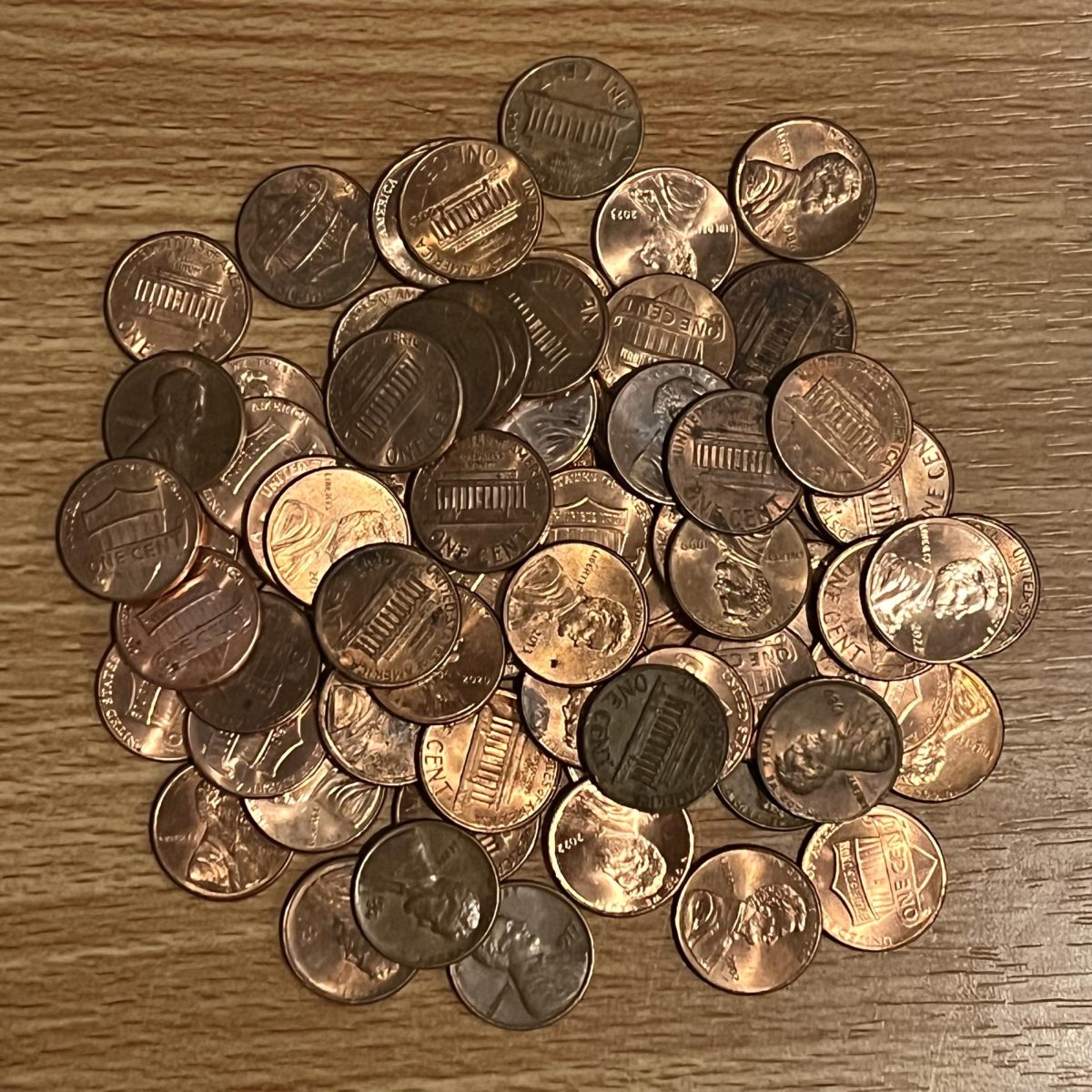Here’s a scenario: you pop into your local 7-Eleven for a drink, or maybe a snack. The total is less than $5.00, so you decide it would make more sense to use the cash you have on hand rather than put it on your card. When you go to the register, do you give the cashier exact change, down to the penny? For most people, the answer is likely a no. They pocket the pennies they’ve given and forget about them as soon as the action is over, or maybe they drop them in the tip jar if they’re feeling charitable, because the 1-cent coins are of no use to them personally.
Even though pennies are insignificant at best and frustratingly useless at worst, people don’t like to use them up because it’s too much trouble to count such a valueless piece of currency. They’ll give the cashier a $10 bill for something that’s $9.67 anyway, because it’s just easier to pocket the change and forget about it. Most of the time, the transfer of pennies is so one-sided (cashier to customer) that it can hardly be said that pennies are “circulated.” If the purpose of currency is to facilitate monetary exchange, then pennies completely fail. To facilitate–to make a process easier–is not what pennies do. They haven’t done that since coin machines stopped accepting them. In fact, some vending machine operators, soft drink companies, and arcade owners have formed the Coin Coalition, an organization that supports phasing out pennies because dealing with them is coming with rising costs related to the inconvenience of it. It’s time for the American government to cut its losses and stop minting pennies.
Something that’s also experiencing rising costs are the metals required to create our coins. In the 2024 fiscal year, a penny cost about 3.69 cents to make, which was a 17% increase from the previous year. Pennies aren’t even the only coin with a negative seigniorage (the difference between a coin’s value and the cost of making it); nickels cost 13.78 cents to make in the 2024 fiscal year. The cost of the metals that go into our coins has been a problem for so long, that in 1982 the composition of pennies was changed from 95% copper and 5% zinc to 97.5% zinc and 2.5% copper. Since 2010, the Secretary of the Treasury has been required to report to Congress every other year about potential changes to the metallic composition of coins that would make production cheaper. According to one such report from 2014, there are no alternatives that would “reduce the manufacturing unit cost of the penny below its face value.” In response to increasing prices, the Mint has been decreasing its penny production: only 3.2 billion pennies were minted in the 2024 fiscal year, when just three years prior, 5.3 billion were minted.
The Treasury is clearly aware that making pennies is a huge loss, and completely illogical. So instead of making tentative half-steps, why not cease penny production entirely? If you can decrease production by 2.1 billion in just three years and it’s gone completely unnoticed, maybe people won’t miss them so much if they’re done away with in totality. Canadians sure didn’t in 2012. In May of that year, the final Canadian penny was ceremoniously minted. Canada was experiencing similar problems with pennies to the ones experienced in America today: negative seigniorage and lack of usefulness. At the time, it cost 1.16 cents to make one Canadian penny (remember, it now costs 3.69 cents to make one American penny!). Canadians deposited their pennies at financial institutions so that the valuable metals could be recovered, and the penny was effectively removed from circulation, though it will remain legal tender indefinitely. Vendors are encouraged to round the transaction total to the nearest five cents. Some countries in the European Union are also beginning to phase out use of the one- and two-euro cent coins. In Belgium, Estonia, Finland, Ireland, Italy, the Netherlands, and Slovakia, cash payments are now rounded to the nearest five cents to discourage use of these coins, although they are still issued to varying extents.
Rounding is among the most prominent reservations for Americans regarding elimination of the penny. Many are reasonably concerned that vendors would constantly round up, and buyers would lose out on a few cents off of every transaction. However, in all countries that have eliminated their one-cent coin, including Canada and Australia, it has become standard practice to round to the nearest five cents. With this system, cents lost and cents gained average out in the long run, so there ends up being no difference in profit for the vendor or buyer. Additionally, in Canada and Australia, goods are not necessarily priced in five-cent increments. Electronic transactions such as those with card or check are not rounded.
With President Trump’s Feb. 9 announcement that he has directed Secretary of the Treasury Scott Bessent to stop production of the penny, the issue has picked up steam. Many critics of Trump question whether or not he has the power to authorize such a change, or if it is required to go through Congress. After all, the last time production of a coin denomination was phased out (all the way back in 1857, with the half cent), it was done by an act of Congress. However, there is really no reason to subject Congress to this issue any longer. According to Robert Triest, a professor in the Department of Economics at Northeastern University, “The process of discontinuing the penny in the U.S. is a little unclear. It would likely require an act of Congress, but the Secretary of the Treasury might be able to simply stop the minting of new pennies.” Members of Congress have attempted to end penny production several times, notably Arizona Representative Jim Kolbe, who pushed for the change for two decades. He faced heavy opposition from zinc miners, and evidently was not successful.
Zinc lobbyists are one of the main reasons the United States still produces pennies. One of the most prominent pro-penny organizations, Americans for Common Cents, is headed by Executive Director and lobbyist Mark Weller who receives large donations from zinc companies to continue his efforts. Sponsors include Jarden Zinc Products, the company that supplies the US Mint with its penny blanks. Americans for Common Cents touts the supposed usefulness of pennies for those small donations that keep charities such as the Ronald McDonald House running. In reality though, many charities, including the Ronald McDonald House, nowadays mainly utilize “round-up” donations solicited at the cash register. There is no reason for lobbyists representing a niche industry to influence the direction of legislation to such a degree, especially when their arguments are so out of touch with the current reality of how Americans spend their money.
There has never been a coin worth as little as the penny is today in American history. When the half cent was discontinued, it had a buying power equal to 17 cents in 2024. In convenience stores all over the country, there are “Leave-a-penny/Take-a-penny” dishes for people to put their unwanted pennies in. When people actually start to leave their money in random places, it’s a clear indication that it has no value. A New York Times Magazine article estimates that “there are 240 billion pennies lying around the United States”—about $7.24 for every person in the country, or enough to hand two to every person born since the dawn of humanity. Coinstar, a company that runs kiosks to convert people’s coins into cash or gift cards, reports that it “recycles more than 43 billion coins every year.” The sheer popularity of such a service is testament to the fact that many coins simply don’t circulate. Even by 1996, the then-director of the US Mint, Philip Diehl said that two-thirds of the pennies produced in the last 30 years had dropped out of circulation. This phenomenon is a strong contributor to why pennies made up 38% of all coins produced in the 2024 fiscal year.
According to a 2024 report from the Federal Reserve, just 16% of payments made in 2024 used cash. Most people simply don’t use coins that often. A transition away from pennies would not have a huge impact on most people’s lives; in fact, if US banks were to redeem them with citizens just as in Canada in 2012, most would probably just be happy to have them off their hands. Even if the government has to produce some more nickels to make up for the disappearance of pennies from circulation, it would be cutting the enormous waste of expensive zinc. Most of all, it would be saving time for consumers, time for vendors, and time for the Treasury–and time is money, after all.





